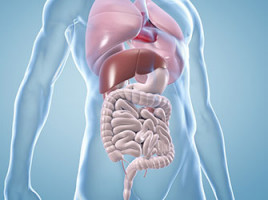
Patients with aggressive neuroendocrine tumours (NETs) have limited treatment options and there are few oncologists who are specialised in this relatively rare disease.
Normally a total gastrectomy (removal of the stomach) is employed in these cases, with a subsequent dramatic reduction in the quality of life for patients.
Now researchers have identified a mutation in the human ATP4a gene that is involved in the gastric acid secretion regulation and has been identified as responsible of an aggressive form of inherited, early-onset gastric NET.
Dr Oriol Calvete, from the Human Genetics Group at the Centro Nacional de Investigaciones Oncologicas (CNIO), Madrid, Spain, presents his work to the annual conference of the European Society of Human Genetics. "Our research has enabled us to determine important clinical 'red lights' for the early diagnosis of patients who will develop these tumours at a younger age, and to identify characteristics that distinguish a good from a poor prognosis for these patients," he says.
The researchers generated a genetically-engineered mouse carrying the mutation.
This developed most of the changes seen in human patients, including not just achlorhydria (a lack of or total absence of gastric secretions in the stomach), but also iron-deficiency anaemia and other pathological changes that replicate the human clinical traits involved, through the presence of which the researchers were able to confirm the mutation as the primary one responsible for the development of gastric NETs.
The researchers were able to restore chlorhydria in affected mice by adding a 3% solution of hydrogen chloride to their drinking water.
Mice that drank this water from birth did not develop gastric NETS, and in those where treatment was started later in the life cycle, the main causative biochemical alterations responsible for their development were blocked.
"Gastric acid regulation is quite complicated," Dr Calvete explains. "Because gastric secretions are activated by the intake of food via the stomach, there are no signs of being abnormal before birth, but by restoring normal gastric acid balance as soon as possible afterwards, we can eliminate the conditions that lead to the development of tumours."
NETS develop in the neuroendocrine system that is responsible for producing the hormones that regulate the working of different organs in the body.
They are rare, incurable, and treatments for them are limited, especially once they become advanced. Because all NETS are classified as rare diseases by regulatory authorities in the EU and the US, there are few drugs available to treat these patients.
"The younger age of onset - around 30 years - of this particularly aggressive form of gastric NET in humans means that it is particularly important to try to find a treatment that is relatively simple, cheap, and does not compromise quality of life," says Dr Calvete. "Total gastrectomy at 30 years old can have a devastating effect, and because NETS are highly infiltrating tumours, does not always mean that it will avoid metastasis. We hope that our work has given a lead towards a way of avoiding patients having to undergo this kind of aggressive surgery."
"Additionally, the genetically-engineered mouse model will allow us to test potential treatments aimed at correcting achlorhydria, not just for gastric NETS, but also for other diseases of the gastrointestinal system such as Barrett's oesophagus (chronic inflammation of the lower part of the oesophagus), or hiatus hernia," says Dr Calvete.
The researchers are now intending to carry out further investigations into the genetic causes of other gastric NETS.
"For example, we have studied two more families with similar pathological characteristics, but with no mutation in the ATP4a gene. This implies that other genes may be responsible and we hope to discover them using a similar methodology," Dr Calvete will conclude.
We are an independent charity and are not backed by a large company or society. We raise every penny ourselves to improve the standards of cancer care through education. You can help us continue our work to address inequalities in cancer care by making a donation.
Any donation, however small, contributes directly towards the costs of creating and sharing free oncology education.
Together we can get better outcomes for patients by tackling global inequalities in access to the results of cancer research.
Thank you for your support.